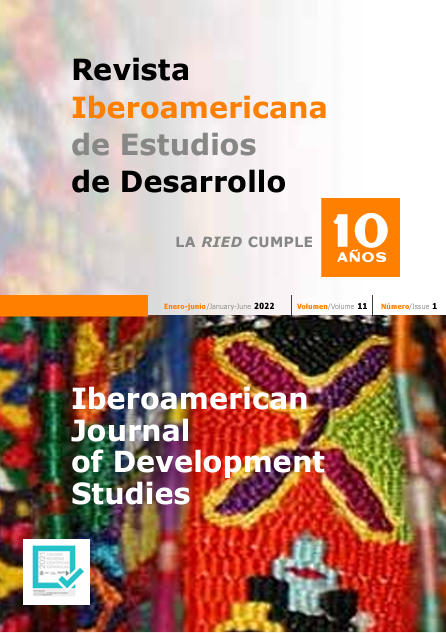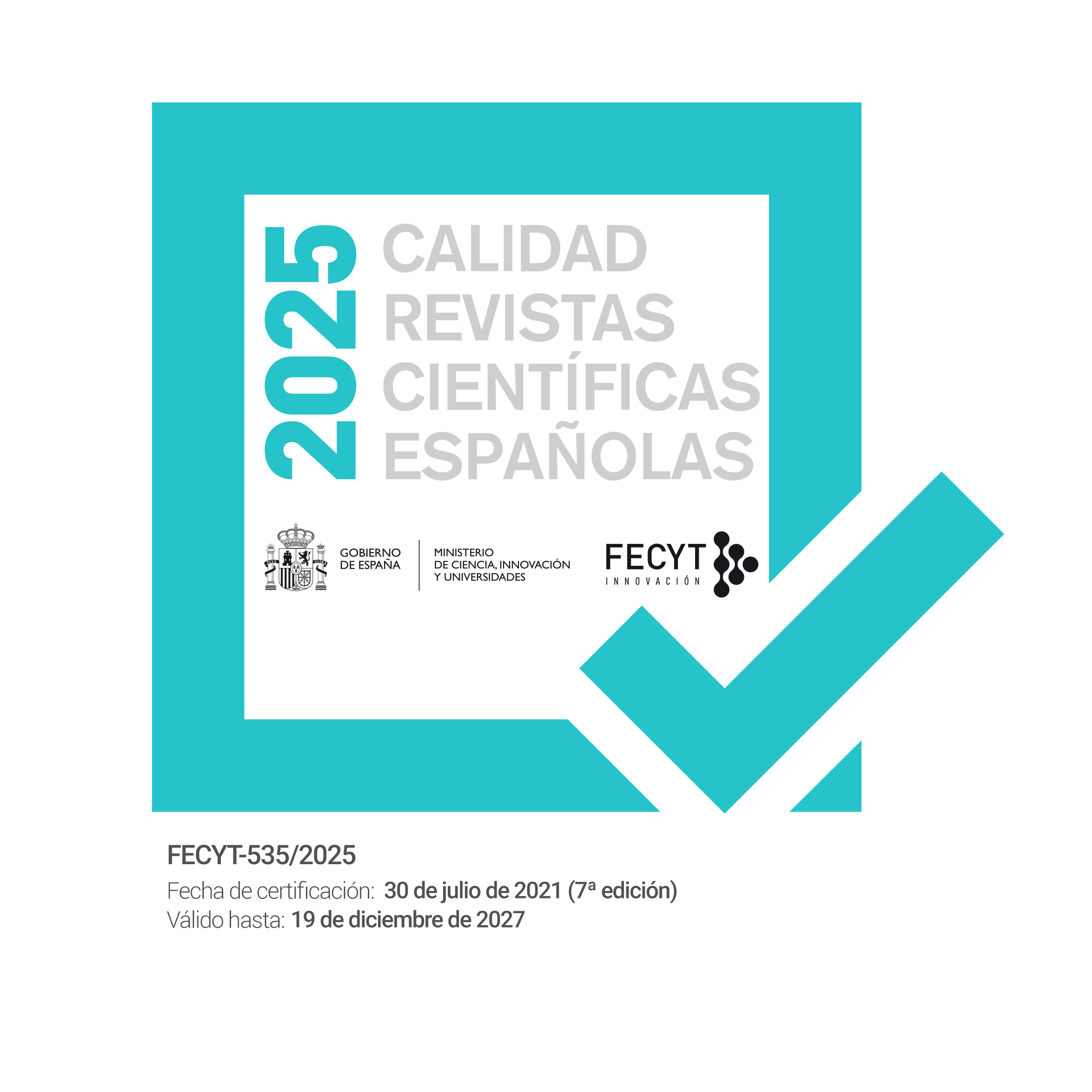Analyzing energy deprivation for cooking in Argentina and Brazil
DOI:
https://doi.org/10.26754/ojs_ried/ijds.603Palabras clave:
pobreza energética urbana, energía para cocinar, modelos logísticos, Brasil, ArgentinaResumen
La falta de acceso a una cocina limpia constituye una dimensión de la pobreza energética que ha llamado la atención de muchas organizaciones internacionales y formuladores de políticas, debido a la relevancia de la cocina, como servicio energético, en la satisfacción de necesidades esenciales. Con este trabajo, se persiguen dos objetivos centrales: se pretende caracterizar a la población con carencia energética para cocinar y detectar si sus características son coincidentes en Brasil y Argentina; además, se analiza si la selección de combustibles tradicionales para cocinar se encuentra relacionada con la presencia de otras privaciones socioeconómicas. Para cumplir con dichos objetivos, se realiza un análisis de estadística descriptiva y se estiman modelos logísticos durante el período 2004-2014. A partir del análisis descriptivo, se considera que las características socieconómicas de la población que presenta carencia energética en la cocina se muestran marcadamente diferentes a aquella que no sufre carencia en esta dimensión. A su vez, existe una fuerte dependencia entre las privaciones multidimensionales y la pobreza energética en la cocina.
Descargas
Referencias
AHMAD S, PUPPIM DE OLIVEIRA J (2015). Fuel switching in slum and non-slum households in urban India. Journal of Cleaner Production 94:130-136.
ALEM Y, BEYENE A, KÖHLIN G, MEKONNEN A (2016). Modeling household cooking fuel choice: A panel multinomial. Energy Economics 59:129-137.
ANP (2019). Nota Técnica No. 027. Rio de Janeiro: Agência Nacional de Petróleo, Gás Natural e Biocombustíveis.
BAHADUR D, BEHERA B, ALI A (2016). Household energy choice and consumption intensity: Empirical evidence from Bhutan. Renewable and Sustainable Energy Reviews 53:993-1009.
BAIYEGUNHI L, HASSAN M (2014). Rural Household fuel energy transition: Evidence from Giwa LGA Kaduna State, Nigeria. Energy for Sustainable Development 20:30-35.
BELAÏD F (2017). Untangling the complexity of the direct and indirect determinants of the residential energy consumption in France: Quantitative analysis using a structural equation modeling approach. Energy Policy 110:246-256. http://dx.doi.org/10.1016/j.enpol.2017.08.027, access October 11, 2020.
BOEMI SN, PAPADOPOULOS AM (2019). Energy poverty and energy efficiency improvements: a longitudinal approach of the Hellenic households. Energy and Buildings.
https://doi.org/10.1016/j.enbuild.2019.05.027, access October 11, 2020.
BOUILLE D (2004) Manual de Economía de la Energía. IDEE/FB, San Carlos de Bariloche.
BRAVO G, KOZULJ R, LANDAVERI R (2008). Energy access in urban and peri-urban Buenos Aires. Energy for Sustainable Development 12(4):56-72.
https://www.researchgate.net/publication/239424300_Energy_access_in_urban_and_peri-urban_Buenos_Aires, access October 11, 2020.
CARDOSO MB, GONZÁLEZ AD (2019). Residential energy transition and thermal efficiency in
an arid environment of northeast Patagonia, Argentina. Energy for Sustainable Development,
, 82-90. https://doi.org/10.1016/j.esd.2019.03.007, access September 5, 2020.
CARUANA MEC, MÉNDEZ FM (2019). La pobreza energética desde una perspectiva de género
en hogares urbanos de Argentina. SaberEs 11(2):133-151.
CASTAÑO-ROSA R, SOLÍS-GUZMÁN J, RUBIO-BELLIDO C, MARRERO M (2019).
Towards a multiple-indicator approach to Energy Poverty in the European Union: A review. Energy and Buildings 193:36-48. https://doi.org/10.1016/j.enbuild.2019.03.039, access September 5, 2020.
CEPAL (2009). Balance preliminar de las economías de América Latina y el Caribe. https://www.cepal.org/es/publicaciones/bp, access January 11, 2020.
CEPAL (2014). Balance Preliminar de las Economías de América Latina y el Caribe. https://www.cepal.org/es/publicaciones/bp, access January 11, 2020.
CEPAL (2019a). Balance Preliminar de las Economías de América Latina y el Caribe. Santiago de Chile. https://repositorio.cepal.org/bitstream/handle/11362/45000/125/S1901097_es.pdf, access January 11, 2020.
CEPAL (2019b). Ingresos y pobreza en los países del MERCOSUR: nuevos retos para economías en transición al desarrollo. Documentos de Proyectos, (LC/TS.2019/63), Santiago, Comisión Económica para América Latina y el Caribe (CEPAL). https://repositorio.cepal.org/bitstream/handle/11362/44929/1/S1900762_es.pdf, access November 1, 2020.
CHOUMERT-NKOLO J, COMBES P, LE ROUX L (2019). Stacking up the ladder: A panel data analysis of Tanzanian household energy choices. World Development 115:222-235.
COELHO ST, GOLDEMBERG J (2013). Energy Access: Lessons learned in Brazil and perspectives for replication in other developing countries. Energy Policy 61:1088-1096.
COELHO S, PEREIRA A, TUDESCHINI L, GOLDEMBERG J (2018). The energy transition history of fuelwood replacement for liquefied petroleum gas in Brazilian households from 1920 to 2016. Energy Policy 123:41-52.
CONDE-RUIZ JI, AYALA L, CANTÓ O, DE LA RICA S, FERNÁNDEZ M, GORJÓN L, LATORRE N, LÓPEZ LABORDA J, MUÑOZ A, LOMBARDÍA ONRUBIA J, MUÑOZ RODRÍGUEZ M, TORRES R (2020). Informe sobre las medidas de protección a los colectivos vulnerables durante la crisis del Covid-19 (n.o 2020-13). FEDEA.
DAY R, WALKER G, SIMCOCK N (2016). Conceptualising energy use and energy poverty using a capabilities framework. Energy Policy 93:255-264. https://doi.org/10.1016/j.enpol.2016.03.019, access June 5, 2020.
DEL VALLE GUERRERO AL (2020). Repensar la integración energética sudamericana frente a la incertidumbre de la integración regional y la transición energética global. Revista Aportes para la Integración Latinoamericana 42:1-25.
EKOUEVI K, TUNTIVATE V (2012). Household Energy Access for Cooking and Heating: Lessons Learned and the Way Forward. Washington, D.C.: World Bank.
ENEA (2019). Position Paper on Energy Poverty in the European Union, January 2019. http://enr-network.org/wp-content/uploads/ENERGYPOVERTY-EnRPositionPaper-Energypoverty-Jan-2019.pdf, access June 5, 2020.
ENERGY SECTOR MANAGEMENT ASSISTANCE PROGRAM (ESMAP). REGULATORY INDICATORS FOR SUSTAINABLE ENERGY (RISE) (2020). Sustaining the Momentum. Washington, DC: World Bank. https://rise.esmap.org/reports, access October 10, 2020.
FARSI M, FILIPPINI M, PACHAURI S (2007). Fuel choices in urban Indian households. Environment and Development 12(06):757-774.
FELL MJ (2017). Energy services: A conceptual review. Energy research & social science 27:129- 140. https://doi.org/10.1016/j.erss.2017.02.010, access September 5, 2020.
GARCÍA OCHOA R (2014). Pobreza energética en América Latina, CEPAL. https://repositorio.cepal.org/bitstream/handle/11362/36661/S2014039_es.pdf, access June 5, 2020.
GIODA A (2019). Residential fuelwood consumption in Brazil: Environmental and social implications. Biomass and Bioenergy 120:367-375.
GNESD (2014). Energy poverty in developing countries’ urban poor communities: assessments and recommendations. Urban and Peri-Urban energy access. Global Network on Energy for Sustainable Development.
GONZÁLEZ-EGUINO M (2015). Energy poverty: An overview. Renewable and sustainable energy reviews 47:377-385. https://doi.org/10.1016/j.rser.2015.03.013, access September 5, 2020.
GUJARATI D, PORTER D (2009). Econometría. McGraw Hill, México.
GUPTA G, KÖHLIN G (2006). Preferences for domestic fuel: analysis with socio-economic factors and rankings in Kolkata, India. Ecological Economics 57(1):107-121. https://doi.org/10.1016/j.ecolecon.2005.03.010, access September 6, 2020.
HANCEVIC P, CONT W, NAVAJAS F (2016). Energy populism and household welfare. Energy Economics 56:464-474. http://dx.doi.org/10.1016/j.eneco.2016.03.027, access September 6, 2020.
HELTBERG R (2004). Fuel switching: evidence from eight developing countries. Energy
Economics 26:869-887.
HELTBERG R (2005). Factors determining household fuel choice in Guatemala. Environment and development economics 10(3):337-361. https://www.jstor.org/stable/44379145, access September 5, 2020).
HERINGTON MJ, LANT PA, SMART S, GREIG C, VAN DE FLIERT E (2017). Defection, recruitment and social change in cooking practices: Energy poverty through a social practice lens. Energy research & social science 34:272-280. http://dx.doi.org/10.1016/j.erss.2017.09.001, access September 5, 2020.
HOSIER R, DOWD J (1987). Household Fuel Choice in Zimbabwe: An Empirical Test of the Energy Ladder Hypothesis. Resources and Energy 9:347-361.
IBÁÑEZ MARTÍN MM (2018). Exclusión social: los desafíos de su conceptualización y medición. Una propuesta desde un enfoque axiomático. Aplicación para Argentina. Phd thesis in Economics, Universidad Nacional del Sur. http://repositoriodigital.uns.edu.ar/handle/123456789/4475, access September 5, 2020.
IEA (2017). Energy Access Outlook. París: WEO e STO.
IEA (2019). Sustainable Development Goal 7, Access to clean cooking. París: WEO e STO. https://www.iea.org/sdg/cooking/, access October 10, 2020.
IEA (2020). Access to clean cooking. https://www.iea.org/reports/sdg7-data-and-projections/access-to-clean-cooking, access October 11, 2020.
IRENA (2021). Bioenergy. https://www.irena.org/bioenergy, access April 10, 2021.
ISRAEL D (2002). Fuel choice in Developing countries: Evidence from Bolivia. Economic
Development and Cultural Change 50(4):865-890.
LATTES A (2001). Población urbana y urbanización en América Latina. La ciudad construida 49:49-77. https://biblio.flacsoandes.edu.ec/libros/digital/43655.pdf, access November 1, 2020.
LI K, LLOYD B, LIANG XJ, WEI YM (2014). Energy poor or fuel poor: What are the differences? Energy Policy 68:476-481. https://doi.org/10.1016/j.enpol.2013.11.012, access September 6, 2020.
LIAO TF (1994). Interpreting probability models: Logit, probit and other generalized linear models (Sage University Paper series on Quantitative Applications in the Social Sciences, series no. 07-101). Sage, Thousand Oaks (California).
LUCON O, ÜRGE-VORSATZ D, ZAIN AHMED A, AKBARI H, BERTOLDI P, CABEZA LF, EYRE N, GADGIL A, HARVEY LDD, JIANG Y, LIPHOTO E, MIRASGEDIS S, MURAKAMI S, PARIKH J, PYKE C, VILARIÑO MV (2014). Buildings. In: Climate Change 2014: Mitigation of Climate Change. Contribution of Working Group III to the Fifth Assessment Report of the Intergovernmental Panel on Climate Change [Edenhofer O, Pichs- Madruga R, Sokona Y, Farahani E, Kadner S, Seyboth K, Adler A, Baum I, Brunner S, Eickemeier P, Kriemann B, Savolainen J, Schlömer S, Von Stechow C, Zwickel T, Minx JC (eds.)]. Cambridge University Press, Cambridge, United Kingdom and New York, NY, USA. https://www.ipcc.ch/site/assets/uploads/2018/02/ipcc_wg3_ar5_chapter9.pdf, access September 6, 2020.
MARCHAND R, GENOVESE A, KOH SL, BRENNAN A (2019). Examining the relationship between energy poverty and measures of deprivation. Energy Policy 130:206-217. https://doi.org/10.1016/j.enpol.2019.03.026, access September 6, 2020.
MASERA OR, SAATKAMP BD, KAMMEN DM (2000). From linear fuel switching to multiple cooking strategies: a critique and alternative to the energy ladder model. World development 28(12):2083-2103.
MME, EPE (2018). Balanço Energético Nacional 2018. https://www.epe.gov.br/pt/publicacoes-dados-abertos/publicacoes/balanco-energetico-nacional-2018, access August 10, 2020.
MULLER C, YAN H (2018). Household fuel use in developing countries: Review of theory and evidence. Energy Economics 70:429-439.
NÚÑEZ JA (2019). Cuando lo nuevo no acaba de nacer y lo viejo no termina de morir: un acercamiento al estudio de las matrices energéticas de Argentina y Brasil. Revista de la Red Intercátedras de Historia de América Latina Contemporánea-Segunda Época 10:1-13.
OECD/IEA (2017). Energy Access Outlook. Paris: International Energy Agency.
ÖZCAN KM, GÜLAY E, ÜÇDOĞRUK Ş (2013). Economic and demographic determinants of household energy use in Turkey. Energy Policy 60:550-557. http://dx.doi.org/10.1016/j.enpol.2013.05.046, access September 6, 2020.
PAUDEL U, KHATRI U, PANT KP (2018). Understanding the determinants of household cooking fuel choice in Afghanistan: a multinomial logit estimation. Energy 156:55-62. https://doi.org/10.1016/j.energy.2018.05.085, access September 6, 2020.
PEREIRA A, TUDESCHINI L, COELHO S (2016). Evolution of the Brazilian residential carbon
footprint based on direct. Renewable and Sustainable Energy Reviews 54:184-201.
PINDYCK S, RUBINFELD L (1998). Economentric Models and Economic Forecasts. McGraw
Hill, Inc., USA.
PNUD (2018). Pobreza energética: análisis de experiencias internacionales y aprendizajes para
Chile. Santiago de Chile, Programa de las Naciones Unidas para el Desarrollo.
PUIG JP, SALINARDI LHA (2015). Argentina y los subsidios a los servicios públicos: un estudio de incidencia distributiva. Documento de Trabajo, n.o 183, CEDLAS, La Plata. http://sedici.unlp.edu.ar/bitstream/handle/10915/51280/Documento_completo__.pdf?sequence=1, access October 11, 2020.
QUIROGA MV, JUNCOS CASTILLO LC (2020). Políticas sociales y nuevos gobiernos en Argentina y Brasil: un balance a partir de los programas Asignación Universal por Hijo y Bolsa Família. Polis. Revista Latinoamericana 55:1-29. https://journals.openedition.org/polis/18799#text, access November 1, 2020.
RAHUT DB, ALI A, MOTTALEB KA, ARYAL JP (2019). Wealth, education and cooking-fuel choices among rural households in Pakistan. Energy Strategy Reviews 24:236-243. https://doi.org/10.1016/j.esr.2019.03.005, access October 10, 2020.
ROSENTHAL J, QUINN A, GRIESHOP AP, PILLARISETTI A, GLASS RI (2018). Clean cooking and the SDGs: Integrated analytical approaches to guide energy interventions for health and environment goals. Energy for Sustainable Development 42:152-159. https://doi.org/10.1016/j.esd.2017.11.003, access September 5, 2020.
SALVIA A, ROBLES R, FACHAL MN (2018). Estructura sectorial del empleo, nivel educativo de la fuerza de trabajo y diferenciales de ingresos laborales en la argentina (1992-2014). https://revistas.ucm.es/index.php/CRLA/article/view/60700, access October 11, 2020.
SECRETARÍA DE ENERGÍA (2020). Balance Nacional de Energía Útil Residencial. https://www.argentina.gob.ar/produccion/energia/eficiencia-energetica/balance-nacional-de-energia-util/balance-nacional-de-energia-util-residencial, access November 8, 2020.
VELASCO MS (1996). La regresión logística. Una aplicación a la demanda de estudios universitarios. Estadística Española 38:193-217.
WAJNMAN S (2007). Diferenciales de ingresos por sexo, composición de las familias y desigualdad del ingreso familiar en Brasil. Notas de Población 84:131-149. https://repositorio.cepal.org/bitstream/handle/11362/12817/NP84wajnman.pdf?sequence=1, access October 11, 2020.
WILLIAMS R (2006). Generalized ordered logit/ partial proportional odds models for ordinal dependent variables. The Stata Journal 6:58-82.
WORLD BANK (2018). Policy Matters. Regulatory Indicators for Sustainable Energy (RISE), Washington (USA).
ZHANG X-B, HASSEN S (2014). Household fuel choice in urban China: A random effect generalized probit analysis. Working papers in Economics 595, Göteborg.
Descargas
Publicado
Número
Sección
Licencia
Derechos de autor 2022 María Ibánez-Martín, Yormy Eliana Melo, María Florencia Zabaloy

Esta obra está bajo una licencia internacional Creative Commons Atribución-NoComercial-SinDerivadas 4.0.






